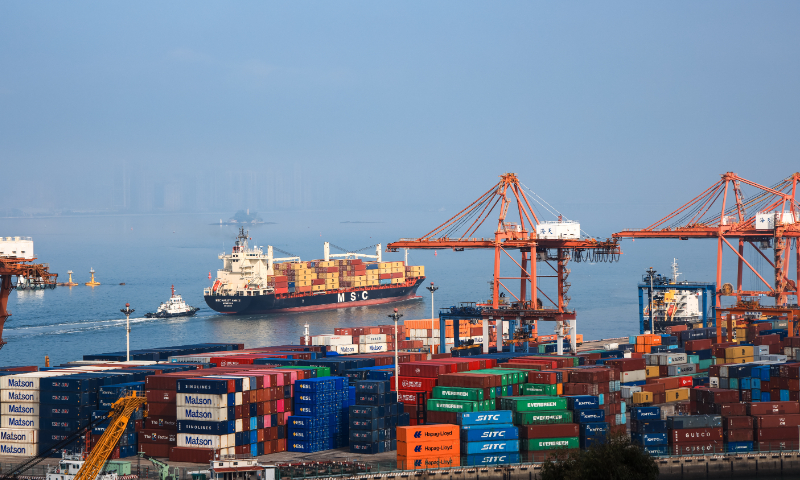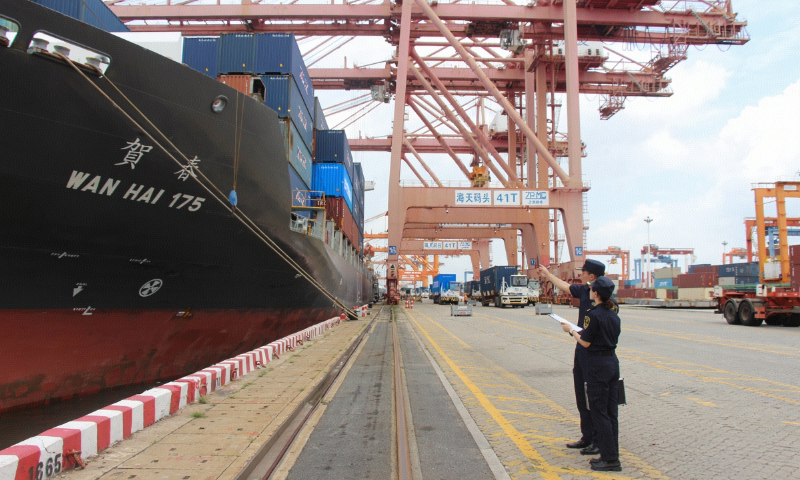Latest
Home >> LatestNumber of Voyages on Silk Road Maritime Container Routes Exceeds 20,000, Showing Flourishing Trade
Source: Global Times | 2025-08-11 08:08 Click:

A view of the Haitian Terminal of Xiamen in East China's Fujian Province File photo: VCG
The cargo vessel MSC ANUSHA III - a named route under the Silk Road Maritime - recently set sail with a resounding horn at the Haitian Terminal of Xiamen in East China's Fujian Province, fully loaded with Chinese-made apparel, footwear, and other goods.
This vessel stood as a testament to the flourishing trade between China and partner countries participating in the Belt and Road Initiative (BRI).
As China's first shipping-themed BRI international integrated logistics service platform, the Silk Road Maritime has established an extensive route network and efficient logistics channels since its launch in 2018, winning the trust of global trading enterprises, according to a post from the Xiamen Municipal Bureau of Commerce.
As of the end of July, 128 Silk Road Maritime-named container routes in China had operated 20,293 voyages, with a container throughput of 23.9196 million TEUs, reaching 147 ports in 46 countries and regions. Among them, Xiamen Port, as the core hub and departure port, has operated 13,029 vessels on 61 named routes, completing a container throughput of 14.6615 million TEUs, the Global Times learned from Xiamen Customs.
Efficient logistics
Through Xiamen Port's Silk Road Maritime routes, exported commodities now touch nearly all aspects of daily life - from common apparel and footwear to the recent best-selling electrical cables and new energy products. An increasing number of "Made in China" goods are making their way to global markets via this platform, according to Li Nan, general manager of Fujian Silk Road Maritime Management Co.
"After nearly seven years of hard work, the Silk Road Maritime has grown into a diversified, stable and efficient comprehensive logistics service platform, deeply involved in the global supply and industry chains," Li told the Global Times.
To strengthen the Silk Road Maritime network, Xiamen Customs has applied digital port platforms to dynamically track clearance information including ship names, berthing positions, and arrival/departure times. It has optimized ship boarding operations and implemented 365-day, 24-hour customs clearance services, precisely meeting enterprises' customized clearance needs and significantly enhancing Xiamen Port's ability to gather, distribute and allocate international routes and global cargo resources, Xiamen Customs said.
"The operation of Xiamen Port's Silk Road Maritime routes provides us with many conveniences, such as arrangements for ship berthing and priority allocation of yard space by terminals. In terms of port operation hours, terminals also adjust their schedules to coordinate with the platform," Fan Xiehui, Marketing Manager of the Xiamen Branch of SITC Container Lines, told the Global Times.
"All these measures have greatly improved the stability and predictability of our services, enabling us to better serve our customers and help them export their products overseas more smoothly," Fan said, noting that as the market changes rapidly, getting products sold earlier often means better prices.
In June 2022, Xiamen launched China's first Silk Road Maritime e-commerce express line. The e-commerce express line connects Xiamen Port directly with Manila Port in the Philippines. It delivers domestic e-commerce goods to the Philippines within two days and precisely meets the import-export needs characterized by "small batches, high frequency, and strong timeliness," providing cross-border e-commerce enterprises with an "efficient and low-cost" logistics solution, according to Xiamen Customs.

Two customs officers check a cargo ship at the Haitian Container Terminal of Xiamen Port, East China's Fujian Province, on August 6, 2025. Photo: Courtesy of Dongdu Customs
Since its launch in June 2022, the route has operated 152 voyages, with a container throughput of 100,800 TEUs and a cargo value of 16.49 billion yuan in the past three years. Among them, exported cross-border e-commerce goods total 2.25 million items, including bags, footwear and apparel, daily necessities, and fitness equipment, according to Xiamen Customs.
The current shipping time has been shortened as it now takes only 40 to 46 hours from Xiamen Port to Manila Port in the Philippines, while previously, delays might occur caused by various factors like terminal congestion, waiting for berths, or yard space shortages, Fan said.
"Our company's core business focus this year remains on trade between China and the Philippines. What's more, we can clearly feel strong support at the national level. The Xiamen Free Trade Zone has also provided relevant support specifically for cross-border e-commerce. The country attaches great importance to cross-border e-commerce, and local governments have introduced more preferential policies such as subsidies and financial support to encourage cross-border e-commerce enterprises to expand overseas through Xiamen Port," Fan said.
Amid such strong support, Fan's company has switched to larger ships this year, from 650 TEUs to 850 TEUs, driven by improved trade performance. "By this calculation, our loading capacity has increased by around 20 percent to 30 percent compared with last year," Fan added.
Boosting trade
Behind the bustling Xiamen Port Silk Road Maritime lies the continuous expansion of China's "circle of friends" for foreign trade, which has achieved remarkable progress in exploring emerging overseas markets.
Since last year, trade between Xiamen Port and BRI partner countries accounted for half of its total volume, according to Xiamen Customs.
China's vast market also continues to open widely to the world. According to data from Xiamen Customs, in recent years, coal, pulp, logs, barley, sorghum, and beer from around the world have entered the Chinese market through Xiamen Port. Imports of production equipment such as aircraft parts and automatic control instruments have also increased significantly.
Nationwide, China's imports and exports with BRI partner countries reached 11.29 trillion yuan ($1.57 trillion) in the first half of 2025, a year-on-year increase of 4.7 percent, accounting for 51.8 percent of the country's total foreign trade volume, according to official statistics.
Thanks to such robust support, China's total goods imports and exports in yuan-denominated terms rose by 2.9 percent year-on-year to 21.79 trillion yuan during the first six months of 2025, data from the General Administration of Customs showed.